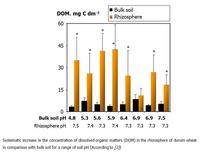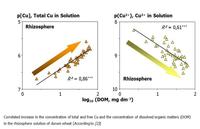Modifications of dissolved organic matters in the rhizosphere
Plants are able to transfer carbon in the form of organic compounds from roots to the soil, known as rhizodeposition.
Rhizodeposition amounts to a substantial flow of carbon since 17% of photosynthesized net carbon is injected into the rhizosphere, which also accounts for 50% of the carbon exported from the aerial parts to the soil [1]. Around 30% of these rhizodeposits integrate the pool of organic matters in the soil, some of them in solution; these are dissolved organic matters (DOMs).
Under the effect of rhizodeposition, it is usual to see a change in DOM concentration in the rhizosphere compared to non-rhizosphere soil.
Given the affinity of many trace elements for these DOMs, the change in DOM concentration in the rhizosphere tends to alter the availability of trace elements and, ultimately, their phytoavailability for the plant.
The RHIZOtest has thus been used to reveal such modifications in DOM concentrations in the rhizosphere and some substantial changes in the complexing properties of these rhizospheric DOMs with regard to trace elements [2].
1.
Nguyen C 2003 Rhizodeposition of organic C by plants: mechanisms and controls. Agronomie, 23, 375-396.
2. Bravin MN, Garnier C, Lenoble V, Gérard F, Dudal Y et Hinsinger P 2012 Root-induced changes in pH and dissolved organic matter binding capacity affect copper dynamic speciation in the rhizosphere. Geochim. Cosmochim. Acta, 84, 256–268.


